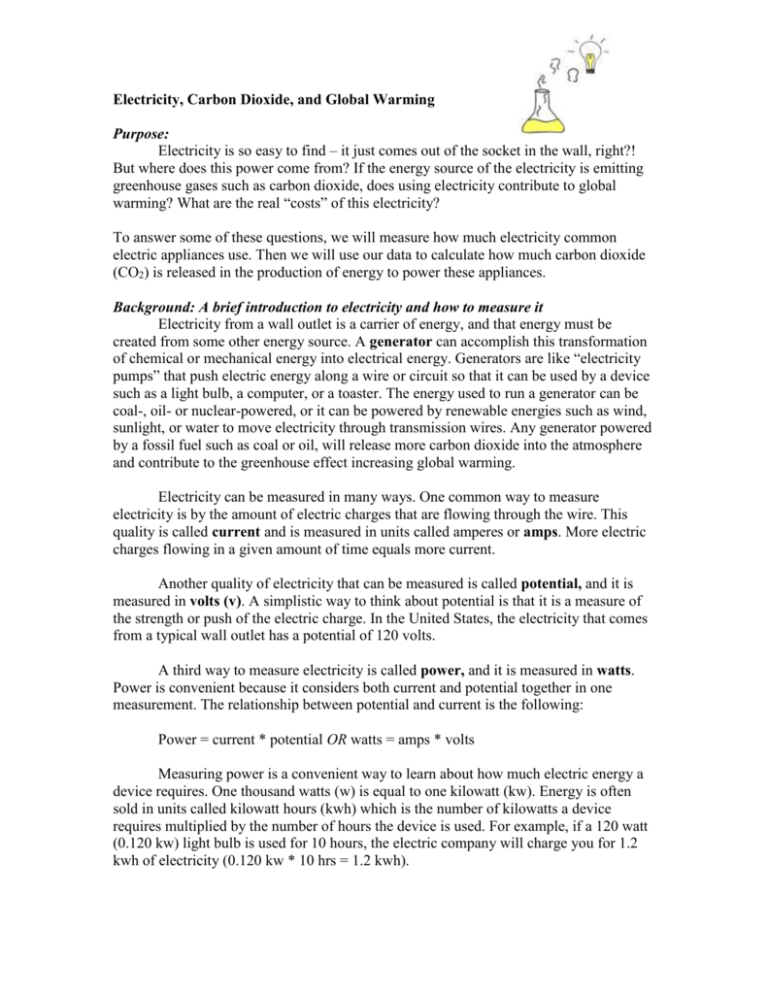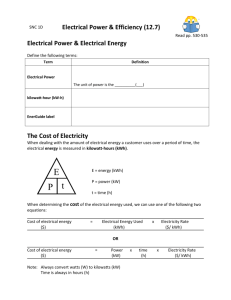Electricity and Carbon Dioxide
advertisement

Electricity, Carbon Dioxide, and Global Warming Purpose: Electricity is so easy to find – it just comes out of the socket in the wall, right?! But where does this power come from? If the energy source of the electricity is emitting greenhouse gases such as carbon dioxide, does using electricity contribute to global warming? What are the real “costs” of this electricity? To answer some of these questions, we will measure how much electricity common electric appliances use. Then we will use our data to calculate how much carbon dioxide (CO2) is released in the production of energy to power these appliances. Background: A brief introduction to electricity and how to measure it Electricity from a wall outlet is a carrier of energy, and that energy must be created from some other energy source. A generator can accomplish this transformation of chemical or mechanical energy into electrical energy. Generators are like “electricity pumps” that push electric energy along a wire or circuit so that it can be used by a device such as a light bulb, a computer, or a toaster. The energy used to run a generator can be coal-, oil- or nuclear-powered, or it can be powered by renewable energies such as wind, sunlight, or water to move electricity through transmission wires. Any generator powered by a fossil fuel such as coal or oil, will release more carbon dioxide into the atmosphere and contribute to the greenhouse effect increasing global warming. Electricity can be measured in many ways. One common way to measure electricity is by the amount of electric charges that are flowing through the wire. This quality is called current and is measured in units called amperes or amps. More electric charges flowing in a given amount of time equals more current. Another quality of electricity that can be measured is called potential, and it is measured in volts (v). A simplistic way to think about potential is that it is a measure of the strength or push of the electric charge. In the United States, the electricity that comes from a typical wall outlet has a potential of 120 volts. A third way to measure electricity is called power, and it is measured in watts. Power is convenient because it considers both current and potential together in one measurement. The relationship between potential and current is the following: Power = current * potential OR watts = amps * volts Measuring power is a convenient way to learn about how much electric energy a device requires. One thousand watts (w) is equal to one kilowatt (kw). Energy is often sold in units called kilowatt hours (kwh) which is the number of kilowatts a device requires multiplied by the number of hours the device is used. For example, if a 120 watt (0.120 kw) light bulb is used for 10 hours, the electric company will charge you for 1.2 kwh of electricity (0.120 kw * 10 hrs = 1.2 kwh). Activity: Obtain a Kill-a-watt energy meter from your teacher. Plug a device into the meter and measure the amps and kilowatts (kw) used for each device. Record your data in the following table: Device Measured current (amps) Measured watts Convert watts to kilowatts (kw) Estimated number of hours used per day Kilowatt hours (kwh) per day Estimated kwh per year Estimated cost per year Estimated CO2 emissions per year Data analysis: After testing several devices and recording the amps and watts for each, make the following calculations: 1. Convert the watts you measured to kilowatts (divide watts by 1000). 2. Enter the amount of time (in hours) the device is used each day. 3. Calculate the kilowatt hours of electricity usage for the device. This is done by multiplying the number of kilowatts by the number of hours it is used in one day. 4. If a year consists of 365 days, how many kwh of electricity will the device use in one year? 5. How much does it cost to run the device for one year? Assume a standard price for electricity at $ 0.12 per kwh. 6. How much CO2 is emitted each year to produce the electricity needed to power the device? Assume 0.58 kg CO2 per kwh which is the average amount of CO2 emitted by power plants in the U.S. to produce 1 kwh of electricity*. Questions for thought: 1. Which devices used the most total electricity (kwh) in a 24 hr period? Which used a lot of kilowatts but only in short bursts? 2. What devices require “phantom power” or electricity when the device is “off”? 3. Assume you left your computer on 24 hrs each day (as many people do!) Calculate how much carbon dioxide is emitted into the atmosphere from just this device alone. 4. Choose one device from the group list that could be used less frequently or not at all. Assume every household in the US uses this device in the same way as we have recorded. Calculate the savings per year in carbon dioxide emissions if the device was used not at all by every household in the US (assume 100 million households, as calculated by the 2000 census). What are the savings if the device was only used half as much of the time? *Source: Energy Information Administration 2006 reports: Energy Information Administration (EIA). 2006a. U.S. Emissions of Greenhouse Gases Report,2006. www.eia.doe.gov/oiaf/1605/ggrpt Energy Information Administration (EIA). 2006b. U.S. Electric Power Industry Net Generation, 2006. www.eia.doe.gov/cneaf/electricity/epa/epa_sum.html Table of terms and equations: Current : measured in amps Potential : measured in volts (v) Power : measured in watts (w) = amps*volts 1 kw = 1000 w 1 kwh = one kilowatt hour = the number of kilowatts used by a device in one hour










